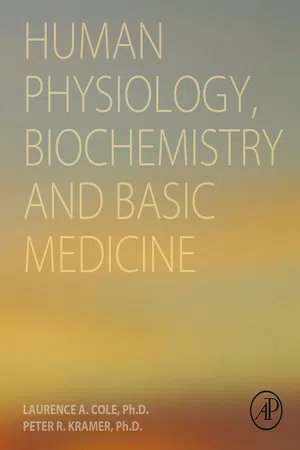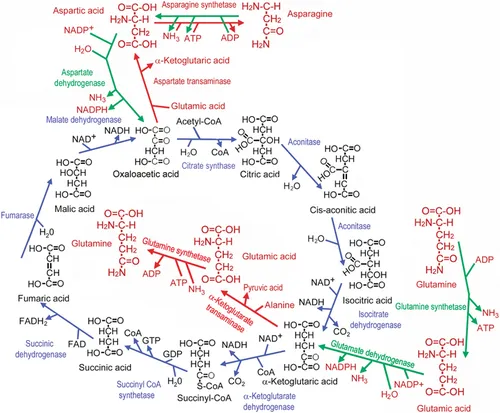
- 248 pages
- English
- ePUB (mobile friendly)
- Available on iOS & Android
eBook - ePub
Human Physiology, Biochemistry and Basic Medicine
About this book
Human Physiology, Biochemistry and Basic Medicine is a unique perspective that draws together human biology, physiology, biochemistry, nutrition, and cell biology in one comprehensive volume.
In this way, it is uniquely qualified to address the needs of the emerging field of humanology, a holistic approach to understanding the biology of humans and how they are distinguished from other animals.
Coverage starts with human anatomy and physiology and the details of the workings of all parts of the male and female body. Next, coverage of human biochemistry and how sugars, fats, and amino acids are made and digested is discussed, as is human basic medicine, covering the science of diseases and human evolution and pseudo-evolution.
The book concludes with coverage of basic human nutrition, diseases, and treatments, and contains broad coverage that will give the reader an understanding of the entire human picture.
- Covers the physiology, anatomy, nutrition, biochemistry and cell biology of humans, showing how they are distinguished from other animals
- Includes medical literature and internet references, example test questions, and a list of pertinent words at the end of each chapter
- Provides unique perspective into all aspects of what makes up and controls humans
Frequently asked questions
Yes, you can cancel anytime from the Subscription tab in your account settings on the Perlego website. Your subscription will stay active until the end of your current billing period. Learn how to cancel your subscription.
No, books cannot be downloaded as external files, such as PDFs, for use outside of Perlego. However, you can download books within the Perlego app for offline reading on mobile or tablet. Learn more here.
Perlego offers two plans: Essential and Complete
- Essential is ideal for learners and professionals who enjoy exploring a wide range of subjects. Access the Essential Library with 800,000+ trusted titles and best-sellers across business, personal growth, and the humanities. Includes unlimited reading time and Standard Read Aloud voice.
- Complete: Perfect for advanced learners and researchers needing full, unrestricted access. Unlock 1.4M+ books across hundreds of subjects, including academic and specialized titles. The Complete Plan also includes advanced features like Premium Read Aloud and Research Assistant.
We are an online textbook subscription service, where you can get access to an entire online library for less than the price of a single book per month. With over 1 million books across 1000+ topics, we’ve got you covered! Learn more here.
Look out for the read-aloud symbol on your next book to see if you can listen to it. The read-aloud tool reads text aloud for you, highlighting the text as it is being read. You can pause it, speed it up and slow it down. Learn more here.
Yes! You can use the Perlego app on both iOS or Android devices to read anytime, anywhere — even offline. Perfect for commutes or when you’re on the go.
Please note we cannot support devices running on iOS 13 and Android 7 or earlier. Learn more about using the app.
Please note we cannot support devices running on iOS 13 and Android 7 or earlier. Learn more about using the app.
Yes, you can access Human Physiology, Biochemistry and Basic Medicine by Laurence A. Cole,Peter R. Kramer in PDF and/or ePUB format, as well as other popular books in Biological Sciences & Biophysics. We have over one million books available in our catalogue for you to explore.
Information
1
Human Body Formed by Units
Introduction

Chapter 1.1
The Cell
Abstract
The cell is the base unit of all animals, plants (eukaryotic and prokaryotic), and other living beings. Cells are often thought of as the smallest unit of a living organism. A cell is made up of many even smaller parts, each with its own function. Human cells vary in size, but all are quite small. Even the largest cell, a fertilized egg, is too small to be seen with the naked eye. Inside each cell is a nucleus containing the signaling chromosomes; a mitochondrion or biochemical power supply where ATP is made; the rough endoplasmic reticulum where proteins are translated and produced; the golgi apparatus that processes proteins; the lysosome that degrades molecules; and multiple other apparatuses or organelles.
Keywords
Nucleus
Cytoplasm
Mitochondrion
Rough endoplasmic reticulum
Golgi apparatus
Lysosome
The cell is the unit of all animal and plant, prokaryotic and eukaryotic, life. There is single cell life like the amoeba, oligocell life like some plankton, and multicell life like humans. Humans actually contain 3.0 × 1013 cells or 30 trillion cells. If you imagine that an average speck of dust weighs just 0.75 μg, then the average 70 Kg man comprises the weight of 93 billion particles of dust. Considering both values, the average cell in the human body weighs just a tiny fraction of the mass of a speck of dust, 1/323 of a speck of dust. The cell is the basic human makeup or unit, a tiny fraction of a speck of dust.
This miniscule body, a fraction of the size of a speck of dust, is an entire village full of organelles or shops and business facilities. There is the mitochondrion, which is like the village power station, the nucleus, where the village mayor controls the village council or chromosomes and orders what is to be made and when, the rough endoplasmic reticulum and ribosomes, which are like the local village factory, hard at work manufacturing the village’s need for proteins, and the Golgi apparatus, another village factory, hard at work refining the synthesized proteins. Then there is the lysosomes or local village dump degrading the molecules not needed by the cells. All buildings in the village or fraction of a speck of dust work happily and eagerly together.
Figure 1.1.1 shows a representative human cell. While there are thousands of types or classes of cells in humans, each is different in shape, makeup, and function. A very general cell is shown in Figure 1.1.1. The number of each organelle varies in each cell type, and some cell types contain specialized functional organelles, which are not shown. Each cell is centered by a nucleus and within each cell is a nucleolus. Each cell has a smooth and rough endoplasmic reticulum, ribosomes, Golgi apparatus, mitochondria, lysosomes, centrioles, and microtubules. Shown are secretory vesicles emerging from the Golgi apparatus as a representative cell (Figure 1.1.1).

Figure 1.1.1 Representative animal cell and its organelles.
The Plasma Membrane
The plasma membrane is the envelope that encloses the entire cell. The envelope is made up of molecules called phospholipids. These are fatty acids with a charged or polar group on the head, and two long noncharged fatty tails comprising carbon and hydrogen atoms. Many different lengths of fatty acid tails, saturated and unsaturated carbon, and hydrogen atoms are found in phospholipids in different cell plasma membranes. One possible phospholipid with two stearic acid-derived fatty tails is shown in Figure 1.1.2.

Figure 1.1.2 The structure of phospholipids.
The phospholipids come together to form a bilayer, with the charged phospho groups on the extreme inside and outside of the membrane and the hydrophobic or noncharged fatty tails in the middle of the bilayer membrane. An example of a possible membrane is shown in Figure 1.1.3. The membrane is spanned by receptor proteins that bind a hormone or autocrine on the outside of the cell, and then transmit a protein signal to the inside of the cell. The bilayer is also crossed by channel protein, another type of protein that lets specific molecules, such as ions like Na+ enter, into the cell (Figure 1.1.3). The charged lipid bilayer blocks prote...
Table of contents
- Cover image
- Title page
- Table of Contents
- Copyright
- Preface
- 1: Human Body Formed by Units
- 2: Human Frames
- 3: Human Organs
- 4: Human Evolution and Pseudo-Evolution
- 5: Nutrition
- 6: Human Diseases and Treatments
- Answers to Chapter Quizzes
- Index